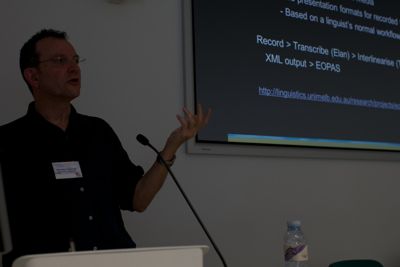Mapping Endangered Records of Endangered Cultures
Duration: 17 mins 40 secs
Share this media item:
Embed this media item:
Embed this media item:
About this item

| Description: | As the global effort to record as much as possible of the world's linguistic diversity proceeds apace there is a great need to ensure the longevity of the records created. While, optimistically, the records created by academic linguists should be 'well-formed' (and so be easily accessioned into an archive), there is a great deal of recording that is not in an academic context and has less chance of being 'well-formed'. More realistically it is also clear that many academics are still not engaged with new methods, and their primary recordings (if they actually make any) risk being lost completely. The first step in visualising such data using web-based tools is for it to be properly described from the moment of recording. ExSite is a tool our team is working on that will create collections on the laptop in a form that allows them to be delivered to an archive. Once the material is in a collection, there are a number of options for access and representation of the collection. The Pacific and Regional Archive for Digital Sources in Endangered Cultures (PARADISEC) is creating streaming access to all items in its collection (subject to deposit conditions) and we have also explored streaming media with time-aligned glossed transcripts (Eopas). We are adding records to our catalog to describe collections that are outside language archive networks, in order to make those collections discoverable. An example is a collection of keyboarded versions of missionary material in languages of the Pacific (http://anglicanhistory.org/oceania/) for which records in our catalog now provide a link from the Open Language Archives Community (OLAC) search tool. To visualise language archives as a global network rather than as a single language archive requires archives to agree on standard representations of their metadata and their collections. The international network of archives, the Digital Endangered Languages and Musics Archives Network (DELAMAN) has the potential to create such standards, as does OLAC. Having created interoperating metdata repositories is a prerequisite to the task of creating visualisations of the collections. Along these lines, see the discussion at the following blog posts: Where are the records? (Blog post on Endangered Languages and Cultures June 7th, 2011, http://www.paradisec.org.au/blog/2011/06/5649) You gotta be in it to win it (Blog post on Endangered Languages and Cultures May 29th, 2011. http://www.paradisec.org.au/blog/2011/05/you-gotta-be-in-it-to-win-it) |
|---|
| Created: | 2012-08-19 16:12 |
|---|---|
| Collection: | World Oral Literature Project Workshop 2012 |
| Publisher: | University of Cambridge |
| Copyright: | Nicholas Thieberger |
| Language: | eng (English) |
| Distribution: |
World
|
| Keywords: | Oral Literature; Oral Tradition; Linguistic Anthropology; Endangered records; Mapping; Endangered cultures; Archives; |
| Explicit content: | No |

